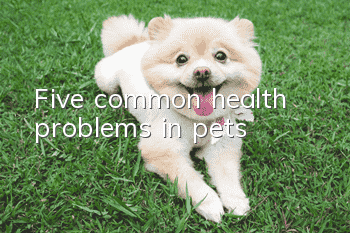Five common health problems in pets

Nowadays, more and more families keep pets and love them like children. Pets bring a lot of fun to the owner's life. However, once the pet suddenly becomes sick, the owner will be anxious and don't know what to do. If everyone pays more attention in daily life and focuses on prevention, once the disease occurs, it can be detected and treated early.
Pet health
(Pictures from the Internet)
Today’s pets are cared for by “eating more and drinking more”,
But please be careful that it may cause different types of diseases in terms of health.
Today I will talk to you about five common diseases.
I hope it can be helpful to everyone!
1. Chronic kidney disease
(Pictures from the Internet)
In recent years, the number of pets suffering from acute renal failure has increased dramatically, with the trend becoming younger. Chronic renal failure in pets is now one of the most important diseases leading to death and cannot be ignored. Chronic renal failure is the gradual deterioration of kidney function. It is usually spontaneous and related to family inheritance. If your pet drinks less water and eats too much meat, it will increase the burden on the kidneys and easily lead to disease.
If your pet has polydipsia, polyuria, anorexia, lethargy, nausea, vomiting, gradual weight loss, dull coat, bad breath, or sudden blindness, it may have kidney disease, and you should go to the hospital for examination as soon as possible!
2. Oral problems
(Pictures from the Internet)
Pets’ teeth are often ignored by their owners and are prone to symptoms such as plaque, calculus, gum inflammation and tooth loss. In severe cases, it can also lead to other physical diseases. Owners can help their pets have healthy teeth by brushing their teeth correctly and establishing a concept of oral hygiene. Preventing dental disease cannot be ignored. If you have not brushed your teeth for a long time, or if you have the following symptoms of dental disease, in severe cases, you may need to have your teeth cleaned to improve them.
Have bad breath and a foul odor in your breath
There is yellow or brown-green tartar and calculus at the gum line
Difficulty eating and drinking, pain or bleeding
Poor appetite and drooling all the time
When touching the gums or mouth,
There may be pain or bleeding
Don’t want to play, bite toys or dare not drink cold water
3. Cataract disease
(Pictures from the Internet)
When it comes to cataracts, many people firstThe reaction is that people can get this disease, but they don’t know that pets can get it too. Cataracts are one of the most common diseases in pets that can lead to visual impairment or even blindness. This disease is congenital or hereditary, and it is also a disease that middle-aged and elderly pets are prone to.
If you observe with the naked eye that there is a milky white color in the deep part of the pet's pupil, no reflection of light, and the fundus cannot be observed with the eyes, you should seek medical attention immediately. Surgical removal of cataracts is the only reliable treatment. There is no experience proving that there are effective drugs that can treat cataracts in pets. Merely relying on injections and medication will not help cataracts.
IV. Heart disease
(Pictures from the Internet)
Heart disease in pets is similar to that in humans. Pets with heart disease can only be discovered through observation by their owners. Although the initial symptoms are not obvious, you can see from the appearance that they are panting rapidly and will pant even if they do not do any exercise. These The phenomenon should attract the attention of the owner.
Pet heart disease is divided into congenital heart disease and acquired heart disease. Congenital heart disease is mostly caused by genetic factors or abnormal heart development caused by various reasons during pregnancy. The scope of acquired heart disease is relatively wide, and heart failure is commonly caused by defects or degeneration of heart valves, dilated cardiomyopathy, certain bacterial, viral and parasitic infections, etc. Symptoms include developmental delay, thinness, inactivity and exercise intolerance; or symptoms such as long-term and stubborn inexplicable cough and asthma, syncope, edema of limbs, and pleural and abdominal effusion.
However, heart diseases in dogs and cats are different. Heart valve diseases are common in small dogs, leading to valvular insufficiency or mitral valve thickening and dehydration; large dogs mostly have dilated cardiomyopathy, which causes thinning of the myocardium or fibrosis. ; Cats mostly suffer from hypertrophic heart disease, and their myocardium is prone to hypertrophy, fibrosis, and necrosis.
Pets with heart disease must be accurately diagnosed before they can be given appropriate drugs. The use of drugs is to maintain the basic functions of the heart. In addition to taking drugs on time, heart health products can also be given as auxiliary treatment, and regular follow-up can ensure the efficacy. .
5. Diabetes
(Pictures from the Internet)
Diabetes is very common among pets, affecting approximately 1 in 200 cats and 1 in 300 dogs. Obesity is the leading cause of disease, especially in cats. Obese cats are four times more likely to develop diabetes than cats of "normal" weight. Blood sugar metabolism is usually controlled by the hormone insulin, which reduces blood sugar levels, and diabetes is an endocrine disease in which blood sugar metabolism is dysregulated. Interestingly, the causes of diabetes in cats and dogs are different!
Dogs develop diabetes because their bodies fail to produce enoughNot enough insulin is medically known as type 1 diabetes or insulin deficiency; in cats, the body does not respond effectively to the insulin produced, which is medically known as type 2 diabetes or insulin resistance. Regardless of the cause, the result is too much blood sugar! This leaves the sick animal susceptible to infections such as cystitis, as well as negative effects on other organs such as kidney failure and cataracts.
Recommended Good Things
Aineng Pet Odor Eliminating Disinfectant can effectively remove body odor/feces odor and other odor molecules! Effectively treats skin diseases caused byfungi/bacteria! Can killparvovirus/canine distemper virus/coronavirusetc.!
It is edible grade for pets, does not contain fragrances, does not contain chemicals, can be sprayed directly, and is harmless to human pets!
Consultation:13028809308 (WeChat synchronization)
Scan the QR code on WeChat to enter the purchase
- How to deal with a dog's illness?
- Can dogs catch colds? How to tell if your dog has a real cold?
- How old does a Corgi have to be before he starts gaining weight?
- Key points for diagnosis of canine urinary stones
- What are the common symptoms of dog allergies?
- Emergency treatment for dog fractures
- The feared pit bull, how to train a pit bull not to bite?
- Symptoms and dangers of dog hernia
- Is it good for dogs to eat strawberries?
- very scary! Why does my dog always bark at the open space! ?



